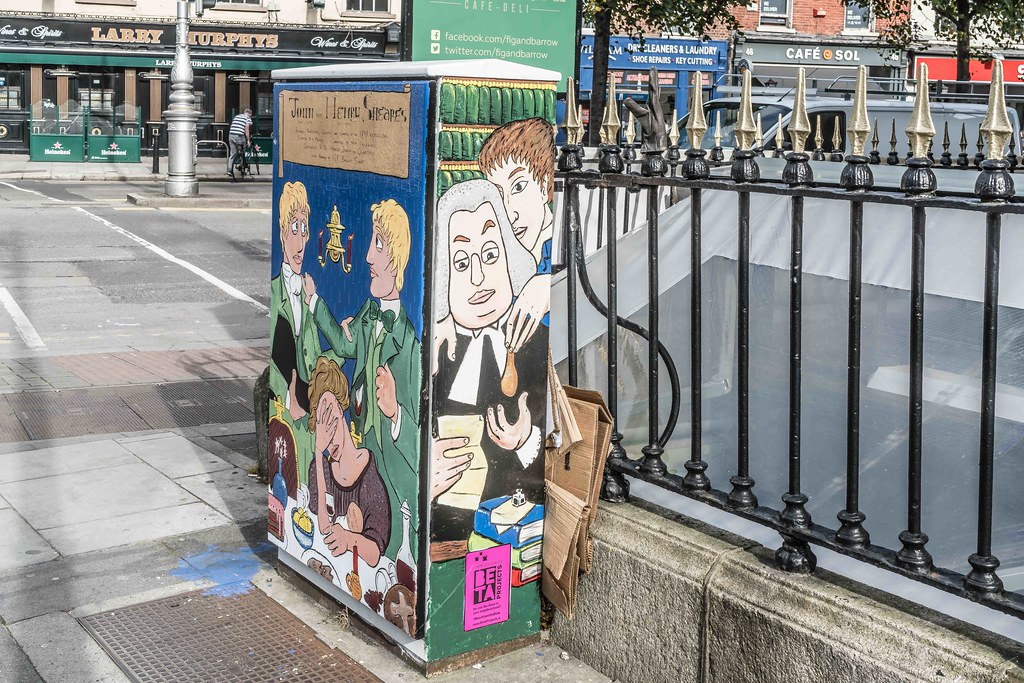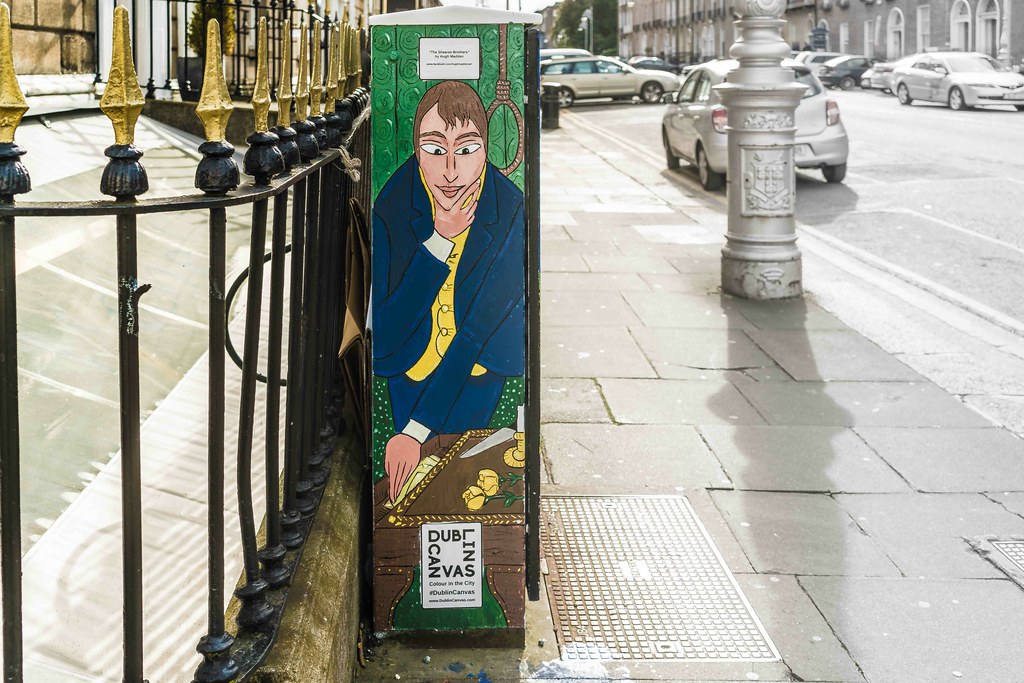STREET ARTIST - HUGH MADDEN
“The Sheares Brothers” by Hugh Madden [Dublin Canvas - Paint A Box]
Dublin Canvas is an idea, a community art project intended to bring flashes of colour and creativity to everyday objects in the City. Less grey, more play. The project takes previously unused public space and transforms it into canvases to help brighten up the City. Making Dublin a more beautiful place to live, work and visit.
The Sheares Brothers, Henry (1753–98), and John (1756–1798) were Irish lawyers and members of the Society of United Irishmen, who died in the 1798 rebellion.
The Sheares brothers were the sons of John Sheares, a liberal banker from Cork who also sat in the Irish Parliament for the Borough of Clonakilty. Henry attended Trinity College Dublin, bought an officer's commission and then studied as a lawyer, being called to the bar as a barrister in 1790. John had qualified as a barrister in 1788. Their father died, leaving a large income of £1,200 p.a.
In 1792 the brothers went to Paris and were swept away by the popular enthusiasms of the French revolution. They met leaders such as Brissot and Roland, both of whom were to be executed in 1793. In particular they witnessed the introduction of the guillotine, on which 1,400 were to die in 1792. On the boat from France to England they met Daniel O'Connell (then a student) who was disgusted by the increasingly bloodthirsty nature of the revolution. O'Connell remained an advocate of non-violence thereafter.
They joined the United Irish movement on their return to Dublin in January 1793, when it was still legal. However, France declared war on Britain (and by extension, on Ireland) in February 1793. The Society's initial aims of securing 1) Catholic Emancipation and 2) universal suffrage were unsuccessful, amounting to the administration's 1793 Relief Act. Its stance became more radical, and in turn the Irish administration feared a group inspired by France, banning it in 1794.
The Sheares brothers principally organised the movement in Cork, while continuing with their legal careers. A Mr. Conway, one of their keenest members in Cork, informed the administration of their activities. During 1793 the brothers also joined the Dublin Society of the United Irishmen, where another spy, Thomas Collins, passed on their names. Their two other less famous brothers had enlisted in the British army and were killed in action. On the arrest of most of the United Irish "Directory" members in March 1798, John was chosen as a replacement on the approach to the outbreak of rebellion. His main act at this point was to decide on the date - 23 May.
The Directory fatally stayed in Dublin, where the United Irish had less support. Already quietly betrayed by Conway and Collins, John also befriended Captain Warnesford Armstrong from County Down, who claimed to be a busy member of the party there. John never checked this, and Armstrong informed the authorities of the brothers' whereabouts, also appearing as a witness in the ensuing trial. They were arrested on 21 May and indicted on 26 June.
Inevitably the brothers were tried on 12 July, as the rebellion was at its height, and were hanged, drawn and quartered on 14th. Their lawyer was John Philpot Curran who, with Sir Jonah Barrington, obtained a stay of execution in the hope that Henry would recant, but the brothers were already dead. They were buried at St Michan's nearby.
These days visitors to Dublin are brought to view their coffins on a tour of St. Michan's vaults.
Dublin Canvas is an idea, a community art project intended to bring flashes of colour and creativity to everyday objects in the City. Less grey, more play. The project takes previously unused public space and transforms it into canvases to help brighten up the City. Making Dublin a more beautiful place to live, work and visit.
The Sheares Brothers, Henry (1753–98), and John (1756–1798) were Irish lawyers and members of the Society of United Irishmen, who died in the 1798 rebellion.
The Sheares brothers were the sons of John Sheares, a liberal banker from Cork who also sat in the Irish Parliament for the Borough of Clonakilty. Henry attended Trinity College Dublin, bought an officer's commission and then studied as a lawyer, being called to the bar as a barrister in 1790. John had qualified as a barrister in 1788. Their father died, leaving a large income of £1,200 p.a.
In 1792 the brothers went to Paris and were swept away by the popular enthusiasms of the French revolution. They met leaders such as Brissot and Roland, both of whom were to be executed in 1793. In particular they witnessed the introduction of the guillotine, on which 1,400 were to die in 1792. On the boat from France to England they met Daniel O'Connell (then a student) who was disgusted by the increasingly bloodthirsty nature of the revolution. O'Connell remained an advocate of non-violence thereafter.
They joined the United Irish movement on their return to Dublin in January 1793, when it was still legal. However, France declared war on Britain (and by extension, on Ireland) in February 1793. The Society's initial aims of securing 1) Catholic Emancipation and 2) universal suffrage were unsuccessful, amounting to the administration's 1793 Relief Act. Its stance became more radical, and in turn the Irish administration feared a group inspired by France, banning it in 1794.
The Sheares brothers principally organised the movement in Cork, while continuing with their legal careers. A Mr. Conway, one of their keenest members in Cork, informed the administration of their activities. During 1793 the brothers also joined the Dublin Society of the United Irishmen, where another spy, Thomas Collins, passed on their names. Their two other less famous brothers had enlisted in the British army and were killed in action. On the arrest of most of the United Irish "Directory" members in March 1798, John was chosen as a replacement on the approach to the outbreak of rebellion. His main act at this point was to decide on the date - 23 May.
The Directory fatally stayed in Dublin, where the United Irish had less support. Already quietly betrayed by Conway and Collins, John also befriended Captain Warnesford Armstrong from County Down, who claimed to be a busy member of the party there. John never checked this, and Armstrong informed the authorities of the brothers' whereabouts, also appearing as a witness in the ensuing trial. They were arrested on 21 May and indicted on 26 June.
Inevitably the brothers were tried on 12 July, as the rebellion was at its height, and were hanged, drawn and quartered on 14th. Their lawyer was John Philpot Curran who, with Sir Jonah Barrington, obtained a stay of execution in the hope that Henry would recant, but the brothers were already dead. They were buried at St Michan's nearby.
These days visitors to Dublin are brought to view their coffins on a tour of St. Michan's vaults.
SORRY FOR THE DELAY
- COMING SOON TO BOLTON STREET
- STREET ART BY ANNA DORAN
- LOVE MOR - CANAL ROAD
- POPPY CORNER BY DONNA McGEE
- MONTY BY KIM BALE - BAGGOT STREET
- THE SHEARS BROTHERS BY HUGH MADDEN
- STANDPOINT BY LARISSA TAMAYOSHI
- STREET ART BY LA CHIAVE FROM BRAZIL
- MAUREEN O’HARA BY FINK
- DUBLIN CANVAS STREET ART BY HANNAH MD D - BESIDE THE SAMUEL BECKETT BRIDGE
- HEAVY SEAS OF LOVE BY LEARNING MAN
- DUBLIN CANVAS PROGRAMME - PAINTED BOXES IN DUBLIN DOCKLANDS
- “ERRORS ARE FOR DISCOVERY” BY DANIELLE TOWNSEND [DUBLIN CANVAS PROJECT 2015]
- TRAFFIC BOX TSB9M STREET ART 79 CHANCERY STREET - ARTIST NOT YET IDENTIFIED
- PAINTED BOX AT MARY’S LANE - ARTIST NOT YET IDENTIFIED
- CITY FOX BY BRIDGET NI DHUINN BELCHER
- MULTICULTURED BIRDS BY JAMES O’BRIEN



